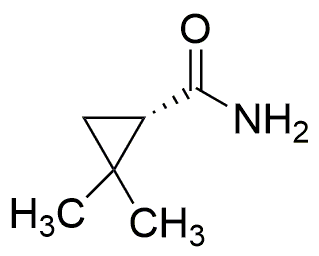(S)-(+)-2,2-Dimethylcyclopropanecarboxamide is widely utilized in research focused on:
- Pharmaceutical Development: This compound serves as a key intermediate in the synthesis of various pharmaceuticals, particularly in the development of analgesics and anti-inflammatory drugs, enhancing their efficacy and reducing side effects.
- Agricultural Chemistry: It is employed in the formulation of agrochemicals, acting as a building block for herbicides and pesticides, which help in improving crop yields while minimizing environmental impact.
- Material Science: The compound is used in the creation of specialty polymers and coatings, providing enhanced durability and resistance to environmental stressors, making it valuable in automotive and construction industries.
- Flavor and Fragrance Industry: It finds application in the synthesis of flavoring agents and fragrances, contributing to the development of unique scents and tastes that are appealing in consumer products.
- Research and Development: As a versatile reagent, it is utilized in various chemical reactions in laboratories, aiding researchers in exploring new compounds and reactions, thus driving innovation in organic chemistry.
General Information
Properties
Safety and Regulations
Applications
(S)-(+)-2,2-Dimethylcyclopropanecarboxamide is widely utilized in research focused on:
- Pharmaceutical Development: This compound serves as a key intermediate in the synthesis of various pharmaceuticals, particularly in the development of analgesics and anti-inflammatory drugs, enhancing their efficacy and reducing side effects.
- Agricultural Chemistry: It is employed in the formulation of agrochemicals, acting as a building block for herbicides and pesticides, which help in improving crop yields while minimizing environmental impact.
- Material Science: The compound is used in the creation of specialty polymers and coatings, providing enhanced durability and resistance to environmental stressors, making it valuable in automotive and construction industries.
- Flavor and Fragrance Industry: It finds application in the synthesis of flavoring agents and fragrances, contributing to the development of unique scents and tastes that are appealing in consumer products.
- Research and Development: As a versatile reagent, it is utilized in various chemical reactions in laboratories, aiding researchers in exploring new compounds and reactions, thus driving innovation in organic chemistry.
Documents
Safety Data Sheets (SDS)
The SDS provides comprehensive safety information on handling, storage, and disposal of the product.
Product Specification (PS)
The PS provides a comprehensive breakdown of the product’s properties, including chemical composition, physical state, purity, and storage requirements. It also details acceptable quality ranges and the product's intended applications.
Certificates of Analysis (COA)
Search for Certificates of Analysis (COA) by entering the products Lot Number. Lot and Batch Numbers can be found on a product’s label following the words ‘Lot’ or ‘Batch’.
*Catalog Number
*Lot Number
Certificates Of Origin (COO)
This COO confirms the country where the product was manufactured, and also details the materials and components used in it and whether it is derived from natural, synthetic, or other specific sources. This certificate may be required for customs, trade, and regulatory compliance.
*Catalog Number
*Lot Number
Safety Data Sheets (SDS)
The SDS provides comprehensive safety information on handling, storage, and disposal of the product.
DownloadProduct Specification (PS)
The PS provides a comprehensive breakdown of the product’s properties, including chemical composition, physical state, purity, and storage requirements. It also details acceptable quality ranges and the product's intended applications.
DownloadCertificates of Analysis (COA)
Search for Certificates of Analysis (COA) by entering the products Lot Number. Lot and Batch Numbers can be found on a product’s label following the words ‘Lot’ or ‘Batch’.
*Catalog Number
*Lot Number
Certificates Of Origin (COO)
This COO confirms the country where the product was manufactured, and also details the materials and components used in it and whether it is derived from natural, synthetic, or other specific sources. This certificate may be required for customs, trade, and regulatory compliance.


